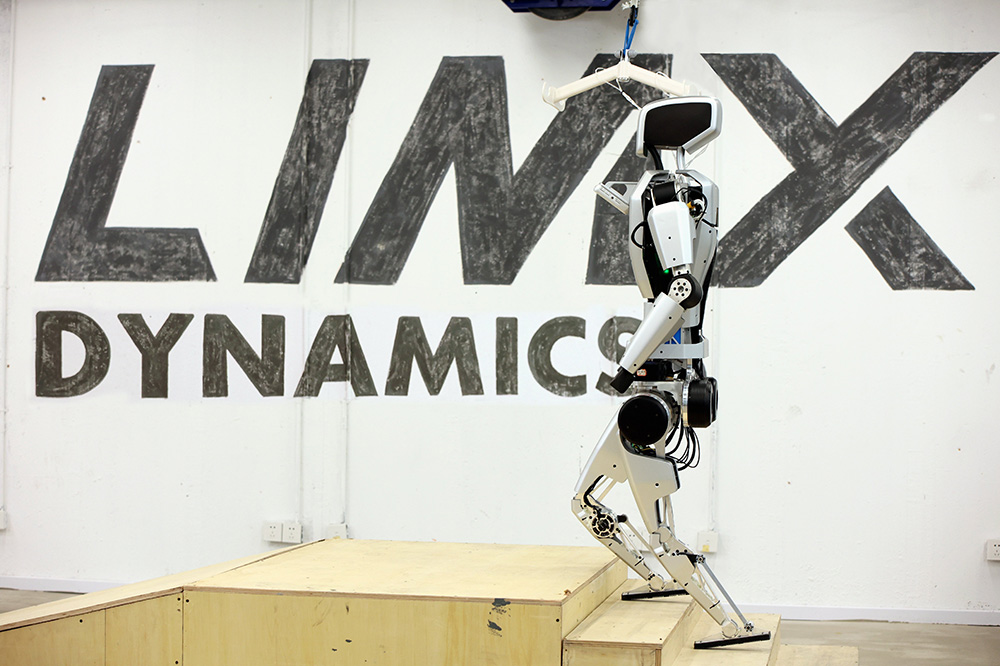|
Listen to this article |
LimX Dynamics Inc. yesterday showed off the latest abilities of its CL-1 humanoid robot in a new video. In the video, CL-1 completed tasks such as climbing stairs and walking down slopes. The robot can also move indoors and outdoors.
The Shenzhen, China-based company said in a blog post that CL-1 was able to do these tasks because it “closed the loop” between real-time perception, gait planning, locomotion control, and hardware and data streams.
During the testing, CL-1 used perception control to adjust its motion proactively, said LimX. This allowed the humanoid to do things like take smooth steps onto a curb, ascend stairs dynamically and fluidly, and walk down a 15-degree slope.
The company’s team tested CL-1 indoors and outdoors, as well as from afternoon to dusk to test its performance in different environmental conditions.
LimX Dynamics said it expects its humanoid robots to eventually be deployed in business-to-business (B2B) and business-to-consumer (B2C) applications. It added that it plans to focus on hazardous scenarios, high-end customer service, automotive manufacturing, and in-home services.

CL-1 ascending the stairs dynamically. | Source: LimX Dynamics
LimX Dynamics designs CL-1 toward general-purpose use
LimX Dynamics explained that it uses advanced motion control, artificial intelligence, and proprietary actuators and hardware to achieve dynamic stair climbing based on real-time perception. The company said its environmental perception technology is a key part of the evolution of its humanoid robots.
CL-1 uses advanced algorithms to achieve full-loop integration of perception, controls, and hardware, according to LimX. It said this allows the robot to break free from the limitation of blind locomotion, and realize real-time interactive motion between the robot and its environment.
LimX noted that it took the cost and efficiency of manufacturing into consideration while designing CL-1. The robot uses its self-developed actuators, which the company asserted provide “exceptional” impact resistance and precise, rapid torque control.
These hardware and software advances lay the groundwork for the robot to be a “general mobile manipulation platform,” said LimX Dynamics. The company said its ambition is for its humanoid and human-centric robot to go anywhere people can go and do anything people can do.
Because it wants its humanoids to be general-purpose robots, LimX said it doesn’t tailor different algorithms for specific functions, forms, application scenarios, or variations on those scenarios. The company has based all of its robots, from its wheeled quadrupeds to its humanoid, are based on a core set of algorithms.
LimX said it focuses on developing motion-control algorithms and using generative AI to unlock the generalization of humanoid robots. The company said CL-1 serves as a platform for it to tackle humanoid technology challenges.

LimX Dynamics’ CL-1 Humanoid Robot outside waving. | Source: LimX Dynamics
China goes all in on humanoids
It would be difficult to talk about the robotics industry in 2023 without mentioning humanoid robots. Stories about humanoids took up the majority of The Robot Report‘s 10 most popular stories this year, and it has been a major trend in the industry.
In November, Beijing’s Ministry of Industry and Information Technology (MIIT), which oversees the country’s industrial sector, published a guideline detailing goals for the country’s ambitions to develop humanoid robots. According to the document, China aims to be ready to mass-produce humanoids by 2025.
While LimX Dynamics has worked on bipedal robots before, this is the first time it has released a full humanoid robot. It faces competition from several companies, including Agility Robotics, Figure AI, Sanctuary AI, Unitree Robotics, Apptronik, and more. Most of these companies, however, are focusing on starting with logistics applications, while LimX Dynamics said it hopes to create a general-purpose robot.
 Submit your nominations for innovation awards in the 2024 RBR50 awards.
Submit your nominations for innovation awards in the 2024 RBR50 awards.





